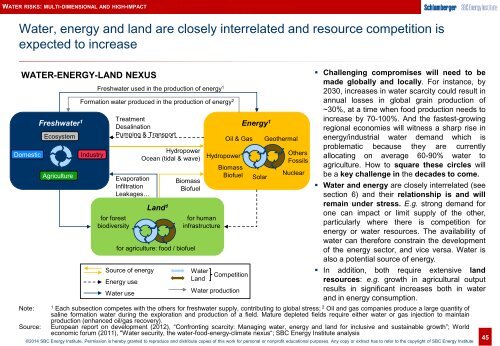1wMF53w
1wMF53w
1wMF53w
You also want an ePaper? Increase the reach of your titles
YUMPU automatically turns print PDFs into web optimized ePapers that Google loves.
WATER RISKS: MULTI-DIMENSIONAL AND HIGH-IMPACT<br />
Water, energy and land are closely interrelated and resource competition is<br />
expected to increase<br />
45<br />
WATER-ENERGY-LAND NEXUS<br />
Domestic<br />
Note:<br />
Source:<br />
Freshwater 1<br />
Ecosystem<br />
Agriculture<br />
Industry<br />
Freshwater used in the production of energy 1<br />
Formation water produced in the production of energy 2<br />
for forest<br />
biodiversity<br />
Treatment<br />
Desalination<br />
Pumping & Transport<br />
Evaporation<br />
Infiltration<br />
Leakages…<br />
Hydropower<br />
Ocean (tidal & wave)<br />
Land 1<br />
Biomass<br />
Biofuel<br />
for agriculture: food / biofuel<br />
Source of energy<br />
Energy use<br />
Water use<br />
for human<br />
infrastructure<br />
Water<br />
Land<br />
Oil & Gas<br />
Hydropower<br />
Biomass<br />
Biofuel<br />
Competition<br />
Water production<br />
Energy 1<br />
Others<br />
Fossils<br />
• Challenging compromises will need to be<br />
made globally and locally. For instance, by<br />
2030, increases in water scarcity could result in<br />
annual losses in global grain production of<br />
~30%, at a time when food production needs to<br />
increase by 70-100%. And the fastest-growing<br />
regional economies will witness a sharp rise in<br />
energy/industrial water demand which is<br />
problematic because they are currently<br />
allocating on average 60-90% water to<br />
agriculture. How to square these circles will<br />
be a key challenge in the decades to come.<br />
• Water and energy are closely interrelated (see<br />
section 6) and their relationship is and will<br />
remain under stress. E.g. strong demand for<br />
one can impact or limit supply of the other,<br />
particularly where there is competition for<br />
energy or water resources. The availability of<br />
water can therefore constrain the development<br />
of the energy sector, and vice versa. Water is<br />
also a potential source of energy.<br />
• In addition, both require extensive land<br />
resources: e.g. growth in agricultural output<br />
results in significant increases both in water<br />
and in energy consumption.<br />
1<br />
Each subsection competes with the others for freshwater supply, contributing to global stress; 2 Oil and gas companies produce a large quantity of<br />
saline formation water during the exploration and production of a field. Mature depleted fields require either water or gas injection to maintain<br />
production (enhanced oil/gas recovery).<br />
European report on development (2012), “Confronting scarcity: Managing water, energy and land for inclusive and sustainable growth”; World<br />
economic forum (2011), "Water security, the water-food-energy-climate nexus“; SBC Energy Institute analysis<br />
©2014 SBC Energy Institute. Permission is hereby granted to reproduce and distribute copies of this work for personal or nonprofit educational purposes. Any copy or extract has to refer to the copyright of SBC Energy Institute<br />
Solar<br />
Geothermal<br />
Nuclear<br />
45


